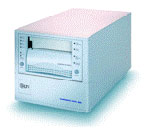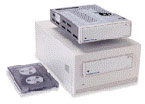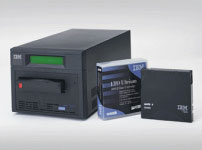 |
||
|
||
| ||
By A. Gorlovoi
A rapid growth of important applications and an increase of data volumes require more attentive attention to data storage systems since any information has its own price and its loss can lead to finance losses, sometimes considerable. Traditionally, storage system are divided into three classes.
Besides, there is one more class - solid-state discs, which are used for making data buffers. But they are not very popular due to a high cost. Today we will talk about technologies and systems of data storage on magnetic tapes. These tapes are the least expensive and quite reliable (more than 30 years) storage medium for organizing archives and backup copying. Despite a great variety of magnetic tapes and cartridges, there are only two basic technologies used in these devices: linear recording (recording with an immovable magnetic head) and helical recording. Both methods are taken from analog magnetic recording. Let's start with linear recording since it appeared earlier. Analog tape recorders appeared a long time ago, and this technology was used for data recording in ES and SM electronic computers. Here we have a wide tape with a great number of parallel tracks positioned along the tape, and a multichannel magnetic head. The tape moves with a drive-mechanism and passes the head, which reads a part (a group) of tracks. At the end the head is positioned for another group of tracks, the drive-mechanism reverses a tape direction, and other tracks are read/recorded. This process repeats until all tracks are recorded. Such method is called serpentine recording. The linear system has its own peculiarities. A tape must pass a magnetic head at the speed of 160 inch/s (70 cm/s) to provide the required record density. The sooner such speed is reached, the less the delays at a start-stop tape moving. That is why, the faster is a drive-mechanism, the higher is a mechanical load on the tape, and usage of modern thin tapes AME is not possible. It is important to position the right way a magnetic track and the head relatively each other. When is driven the tape deviates up and down. Such moving is not critical for tapes with a low record density and for traditional analog recording where a track is wider than a magnetic gap. But a cartridge capacity grows. And since we can't lengthen a tape, we had to increase the number of tracks and use more progressive methods of magnetic recording (RLL, PRML). That is why there must be a special system of tracing and correction of head position. Quantum Corp. and Tandberg Data ASA are the most famous manufacturers of devices with linear recording. Quantum deals with production of hard discs and DLT magnetic tape drives. Tandberg Data ASA produces DLT devices and has a proprietary technology SLR based on quarter-inch cartridges (QIC). The technical characteristics of the DLT and SLR drives are listed in the summary table. DLT. The device uses a 0.5" tape and a single-reel cartridge. The tape is attached to the cartridge and has a loop on another end for the drive mechanism to draw the tape from the cartridge. The cartridge volume is used up completely. The DLT technology is widely used in high-level and middle-level systems. The market offers DLT4000, 7000, 8000. The SuperDLT was started by Tandberg Data from the beginning of April 2001. The DLT4000, 7000, 8000 don't differ much from each other. But the SuperDLT belongs to new generation devices. It uses a modern tape, different magnetic heads, an optical positioning system etc. The SDLT devices are not compatible with old DLT cartridges. But for making it compatible you can install an additional unit of magnetic heads. This will make the drive mechanism more complicated. Tandberg Data DLT1 corresponds to the DLT8000 in capacity, but its performance is twice lower, and it is compatible in reading only with the DLT4000. But it costs not much. SLR. The SLR drives are produced by Tandberg Data ASA and have the following peculiar features.
The new model SLR7 from Tandberg Data is especially interesting. You can look at its characteristics in the table. And it costs less than the DDS4. The collaboration of IBM, HP and Seagate resulted in creation of the LTO (Linear Tape Open format). The technology is a serpentine recording for a 0.5" tape. There are two types of the device. 
The first-generation Ultrium has started to ship in 2001. Today this device is produced by IBM and HP, automated libraries are manufactured by Exabute, HP etc. The Ultrium cartridges are also produced by HP and Exabyte. Now some words about the helical recording. In the mid 50s Ampex started production of VCR with a helical recording. The tape is driven at a small speed (several cm per sec) passing a rotating (at high speed) cylinder which has read/record heads, thus giving us a high relative speed. The disadvantages of this method are: a start/stop process takes less time and the mechanical load on the tape is also smaller. That is why we can use a thinner tape (e.g. AME). The track density is several times higher than in case of the linear recording, since a length of one magnetic track is relatively small and a special mechanism of adjustment of position of the rotating reel is used, and at the expense of a more advanced tape.
But the helical recording has also some drawbacks. First of all, it is a fast deterioration of a tape and reels. But in reality it doesn't take place very soon since when a reel is rotating there is an air layer between a working surface of the tape and the head. On the other hand, modern magnetic tapes with metallic sputtering has a special carbonic covering which is has highly durable and has a constant of friction equal to nearly 0. Besides, the AME tapes are covered with special dry film lubrication. That is why, for example, Mammoth, Mammoth-2 mechanisms doesn't yield to, but even outshines the DLT in durability. Today the market offers 2 classes of devices with the helical recording. Such devices use cartridges with a 4mm tape, and with a 8mm tape. There is also a class of devices based on the Sony Betacam technology which use Betacam-type reels. They are libraries for storing video archives, the capacity of which measures dozens of petabytes. 4-mm devices.  They are based on the DAT technology from Sony. The drives of 4-mm tapes are divided into two generations: DDS-1, DDS-2, DDS-4 and DDS-4. The major manufacturer of 4mm devices is Sony. 8-mm devices.  The technology of analog helical recording (and then digital recording) on a magnetic 8mm tape was offered also by Sony. But for the first time the technology was adapted and optimized for digital data recording by Exabyte. The market offers 8-mm devices from Exabyte (Eliant, Mammoth, Mammoth-2), Ecrix (VXA) and Sony (AIT, AIT-2). The specifications for all these devices are given in the summary table. The 8-mm devices have a lot of similar features, but there are also some differences. * Sony has designed a very complicated drive mechanism. In case of the slightest failure the tape shifts up or down, what usually causes damage of the tape. The Exabyte drive mechanism doesn't have such assembly: the tape moves linearly at the expense of the reels, and the way of tape moving is simplified. The mechanism is more reliable, the tape deterioration becomes not so severe, and there is a possibility to use thinner improved AME tapes.
Now let's compare the existent technologies. Their variety proves that there is no an ideal one. For estimation of technologies there are definite criteria: linear record density, format effectiveness, track density. A linear record density is the number of data recorded on a unit of length of the magnetic track (KB/inch)
Super DLT, DDS and Travan have the maximum linear record density. DLT and Mammoth have some reserve for development. * G1 Super DLT started to ship to OEM and into distribution channels in the beginning of 2001. Format effectiveness is a ratio of the overall number of bits on a tape and the number of data bits. These two values do not coincide since the tape also contains correcting codes, parity bits and other service data. It is measured in %. The optimal effectiveness is 75%.
The DLT and Travan has the optimal and nearly limiting efficiency, 8-mm and 4-mm devices still have some reserve. It is accounted by the fact that the helical recording hasn't yet optimized for digital data recording, unlike the linear recording technology. The highest and nearly limiting for today's media and magnetic heads track density it typical of DDS devices. The devices with linear recording has some reserve for the further capacity growth. Each technology has both advantages and disadvantages. The DLT technology has the following highs: a large part of working devices and libraries, and compatibility between different DLT models. It makes exchange of cartridges among users possible. But on the other hand, a necessity to support compatibility with earlier models prevents rapid development of the DLT format as far as capacity and speed are concerned. The helical recording appeared later than the linear one. As a result, the same volumes of data are recorded on a much less surface of a tape. The advantage of such devices are a more compact size, smaller cartridges, an advanced durable magnetic tape. The drive of the Mammoth-2 tapes is the most efficient in its class and the most expensive among all devices on the market. Besides, its capacity is the largest for its class. However, it yields to the SDLT and Ultrium in capacity, but these two devices belong to the next generation. Newer generation devices are usually incompatible with older models. For example, when turning from the Eliant 820 to the Mammoth, old cartridges can't be used since the Mammoth uses a new generation AME tape with other record parameters. Besides, exchange of cartridges between similar devices (e.g. Mammoth, AIT or VXA) is also impossible due to the difference in formats. The situation with the SDLT and Ultrium is the same. In case of cheap DDS drives the exchanges of cartridges of even the same class (DDS -2, -3, -4) is not also always possible. The most durable devices are based on the AME tapes. The Mammoth-2 is a champion in speed and capacity. Its superiority is proved with a great deal of tests. The drive yields only to SuperDLT and LTO Ultrium. The Mammoth-2 started to ship in the beginning of 2000, and the SuperDLT - a year later. The DDS and new SLR 7 from Tandberg Data are the cheapest. They are mainly used in workstations and entry-level servers. Now let me draw a conclusion. The DDS technology (4mm) suits those fields where high speed and high durability are not required. The DDS drive is very compact, it takes little space and can be mounted in any computer without problems. It is very cheap. The DLT and SLR technology are intended for intensive operation (24-hour usage). The SLR devices have a high speed and large capacity, as well as high reliability and a low cost. Taking into consideration a better (than that of DDS) compatibility of cartridges, the entry-level SLRs can be used instead of DDS, and a higher level devices can be an alternative to the Mammoth and DLT technologies. The DLT technology ensures a large capacity and a high speed; it is used in the middle-level systems for automatic libraries or autonomous devices. The compatibility of the DLT cartridges is perfect. The DLT1 devices are compatible in reading only with the DLT4000, but their price is comparable with high-level DDS, and their capacity corresponds to the DLT8000. The SDLT, which started to ship in April 2001, is not compatible with the DLT7000, 8000 etc., what places them on one level with the LTO Ultrium. The SDLT has a better capacity and a lower cost as compared with the Ultium. According to the specification, the LTO Ultrium has a higher speed. 8-mm devices (AIT, Mammoth) has the highest speed and the largest capacity (except Super DLT and Ultrium). If you want a high speed and there is a need in cartridge compatibility, the optimal solution will be AIT -2 or Mammoth-2. The AIT costs a bit lower. The Mammoth-2, AIT-2, DLT were compared a lot of times with different applications in real conditions under various operating systems, and the Mammoth-2 always shined. The AIT-2 and Mammoth-2 provides a lower (than that of DLT or LTO) specific data storage cost. Besides, the Mammoth-2 from Exabyte is the only device which can have a Fibre Channel interface (optical or "copper", depending on the the GBIC module). It is very important when building storage area networks (SAN), which primarily use the FC interface. In this case the Mammoth-2 drive connects to a FC commutator or hub directly without FC - SCSI bridges. The drives have already started to ship. And now there is a summary table of all technical characteristics of different magnetic tape drives
Write a comment below. No registration needed!
|
Platform · Video · Multimedia · Mobile · Other || About us & Privacy policy · Twitter · Facebook Copyright © Byrds Research & Publishing, Ltd., 1997–2011. All rights reserved. | |||||||||||||||||||||||||||||||||||||||||||||||||||||||||||||||||||||||||||||||||||||||||||||||||||||||||||||||||||||||||||||||||||||||||||||||||||||||||||||||||||||||||||||||||||||||||||||||||||||||||||||||||||||||||||||||||||||||||||||||||||||||||||||||||||||||||||||||||||||||||||||||||||||||||||||||||||||||||||||||||||||